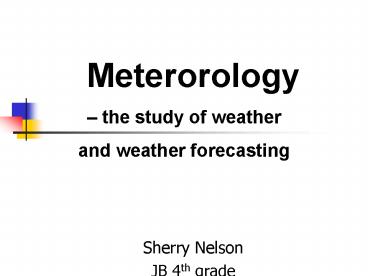Sherry Nelson - PowerPoint PPT Presentation
1 / 21
Title:
Sherry Nelson
Description:
Climate is the overall temperature and patterns of weather in a particular place ... The thunderstorm that pounded south-central Nebraska in June ended up leaving ... – PowerPoint PPT presentation
Number of Views:34
Avg rating:3.0/5.0
Title: Sherry Nelson
1
Meterorology the study of weather and
weather forecasting
- Sherry Nelson
- JB 4th grade
2
Weather
- Three Main Components
- of Weather
- movement of air
- amount of water in the air
- temperature
3
Climate
- NOT the same as weather!
- Climate is the overall temperature and patterns
of weather in a particular place (region) - Think of the differences between Hawaii and
Alaska this is climate!
4
Weather Prediction
- Meterologists predict the weather
- Today they use many tools
- satellites in space
- radar equipment on the ground
- weather balloons
- weather planes
5
Types of Precipitation
- Any and all forms of water, either in liquid or
solid state, that falls from clouds and reaches
the ground. Deposits of dew, fog and frost are
not included in this category. - Rain
- Hail
- Sleet
- Snow
http//www.hazelwood.k12.mo.us/cdavis01/map2000/3
rd/256,1,Slide 1
6
How are Clouds Formed?
- Clouds form when the air rises.
- As a blob of air rises it expands and gets
colder. The colder air cannot hold as much water
as warmer air. As the temperature and air
pressure continue to drop, tiny water droplets
group together into clumps called cloud
droplets. At this point, the blob of air becomes
a visible cloud.
7
- If the cloud keeps going up, the cloud droplets
will clump together and form water droplets.
These water droplets are too heavy to float in
the air and they fall from the sky as either rain
or snow. - The word nimbus means rain cloud.
8
Types of Clouds
- Shape
Weather - Cirrus Curly Wisps Fair
- Nimbus Puffy Dark Thunderstorms
- Cumulus Puffy Warm Sunny
- Stratus Flat Rain
Drizzle
9
What are Clouds?
- Clouds are made of water. They are either small
liquid water drops or tiny pieces of ice. - Meteorologists are scientists who study the
weather. They rank clouds by their height and
whether they are flat or puffy.
10
Cirrus are high altitude wispy clouds. They are
usually quite thin and often have a hairlike or
filament type of appearance. The curled up ends
as depicted in this picture are very common
features.
11
Cirrocumulus are high clouds that have a distinct
patchy and/or wavelike appearance, such as, in
our patchwork cirrocumulus photo, composed of
many individual cloud elements, or in our wavy
cirrocumulus photo with its banded linear
structure.
12
Cirrostratus are high clouds that usually blanket
the sky in ill-defined sheets. These clouds are
usually optically thin and the sun and moon can
usually shine some light through. Like other
stratiform clouds, one usually can't detect
distinct cells or sharp features.
13
Fog can be considered as a low stratus cloud in
contact with the ground. When the fog lifts, it
usually becomes true stratus.
14
Stratocumulus can be widely scattered (as
depicted in this photo, but are usually
concentrated closer together in clusters or
layers and have very little vertical
development. These relatively flat clouds
usually lack the sharp edges and "popcorn"
appearance of most normal cumulus clouds.
15
Cumulonimbus, as shown in this photo (with
cumulus in the foreground), are the clouds that
can produce lightning, thunder, heavy rains,
hail, strong winds, and tornadoes. They are the
tallest of all clouds that can span all cloud
layers and extend above 60,000 feet. They
usually have large anvil-shaped tops (as shown)
which form because of the stronger winds at
those higher levels of the atmosphere.
16
Sometimes, strong cumulonimbus clouds can have
appendages protruding from the base of the
cloud, which are called "mammatus" clouds
because they resemble the mammary glands of
mammals. They indicate that the atmosphere is
quite unstable and can also be an indicator of
impending severe weather.
17
Great pictures links for clouds.
- Copy paste this link in your web browser took
bar. - http//ww2010.atmos.uiuc.edu/(Gh)/guides/mtr/cld/c
ldtyp/home.rxml
18
Weather Prediction
- For each of the following weather scenarios,
indicate what impact each component (cloud cover
winds advection snow cover) will have on
forecasted temperatures. Indicate whether each
weather condition will lead to lower or higher
temperatures or indicate "None" if it is not a
factor.
19
Largest Hailstone in U.S. History Found
- National Geographic News August 4, 2003
- It's official. The thunderstorm that pounded
south-central Nebraska in June ended up leaving
something for the record books The largest
hailstone ever recovered in the United States, a
seven-inch (17.8-centimeter) wide chunk of ice
almost as large as a soccer ball. - http//weathersavvy.com/Q-Storms_Hail_Largest.html
- The old record for the largest hailstone had a
diameter of 5.7 (14.5 centimeters) inches, a
circumference of 17.5 inches (44.5 centimeters),
and was found in Coffeyville, Kansas, on
September 3, 1970.
20
"I looked outside, and it was raining
volleyballs," he said.
21
Imagine a baseball dropped from an airplane
flying at 30,000 feet ... imagine that baseball
reaching speeds of 120 MPH as it falls to the
ground ... and imagine you're under it!































